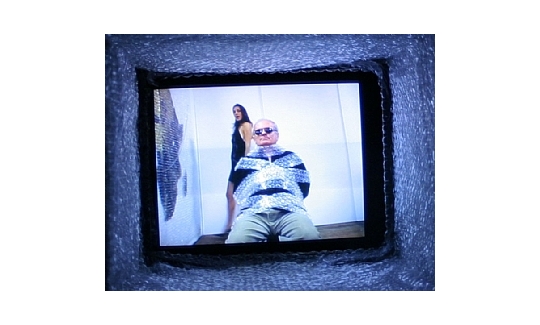"Emergency Exit"
Joshua Neustein: Berlin - Luftkissen
Saturday, 24.06.06
Sunday, 29.10.06
More info:
04-6030800Joshua Neustein: Berlin - Luftkissen
Dov Or-Ner and Tamar Dubrovsky: Have You Ever Considered Suicide?
June 24, 2006 - October 29, 2006
Curator: Ilana Tenenbaum
In the "Emergency Exit" exhibition space, a work by Joshua Neustein is projected alongside a joint work by Dov Or-Ner and Tamar Dubrovsky. Video works by two of these artists - Neustein and Or-Ner - are also included in the historical exhibition "Live Acts - Performing the Body". The exhibition of these recent works underscores their affiliation with forms of expression characteristic of early video art in the 1970s, which tended to focus on a restricted set of actions and images of the body and on the expansion of the temporal dimension. These two works are characterized by a clearly morbid element, which is related to the artist himself and to his perception of the creative process.
In Joshua Neustein's work Berlin - Luftkissen (2006), a man and a woman are portrayed in an estranged and absurd situation, which is filmed from a low, stationary vantage point. The man, Neustein himself, is tied up with strips of bubble wrap, and is wearing sunglasses that prevent us from seeing his eyes. The young woman circles around him incessantly, rubbing against him sometimes in a seemingly unintentional manner while reciting a German text that Neustein repeats in English; the two languages run like two parallel lines, without entering into a dialogue with one another. The text is composed of thoughts about contemporary art in the virtual world - art that operates within a culture characterized by increased mobility and dizzyingly rapid distribution processes. These processes, according to Neustein, result in an experience of emptiness
and disappearance.
The bubble wrap - air that has been packaged and imprisoned, and which alludes to the cliché "the presence of absence" - serves as a key metaphorical expression of this experience in Neustein's work. This industrial material, which is also used to package art works, amount to the industrialization and distribution of emptiness.
The bubble wrap used to tie Neustein's body is also used to create the body of the tube through which viewers watch the projection. The structure, which is reminiscent of the sleeve used to connect an airplane to a terminal, functions for the viewers as an estranged and industrialized "suction sleeve" that connects them to the world of images. In this manner, Neustein notes, the viewers themselves are performing an action that may be defined as art.
The joint work by Dov Or-Ner and Tamar Dubrovsky, Have you ever considered suicide? (2004-2006), surrounds the art object with images of suicide and destruction. The ongoing collaboration between these two artists, which began on Kibbutz Beeri in 2004, is concerned with the destruction of art works and their burial in the earth. Their actions, which include burial at sea and in the earth, as well as the explosion and burning of objects in a pit, are based on the four ancient mythological elements - Earth, Water, Air and Fire. Although these actions resemble in part human funerals, they simultaneously refer to acts of disposal and purification, and to setting off on a new path. In contrast with Or-Ner's burial projects during the 1970s, which were mainly preoccupied with preservation and with the memory of social and political events, these recent acts of burial engender destruction.
In the large projection on the "Emergency Exit" wall, we see the process beginning with the removal of the works from the studio, and ending with their destruction. Three extremely short films projected on nearby television sets display symbolic actions related to violence and to suicide. In the first film, Preparation, we see a table set with plates containing tools for committing suicide: a pistol, a knife, a rope and pills; in the second film, Violence, these objects are thrown into a black pit and violently destroyed; in the third film,Completion, the broken fragments are gathered and buried in the earth. The suicidal destruction of the artistic object may be read as an allusion to current events, which contain suicidal and destructive, terror-related elements.

